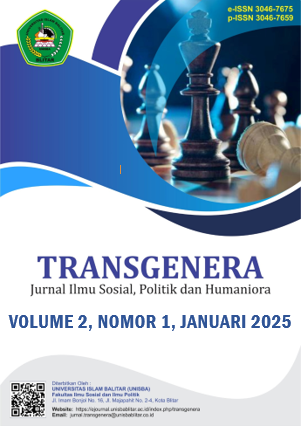Konsep Birokrasi Korupsi di Indonesia dalam Teori Bureaucratic Oversupply Model
DOI:
https://doi.org/10.35457/transgenera.v2i1.4134Keywords:
Bureaucracy, Bureaucratic Oversupply model, Corruption, Bureaucratic ReformAbstract
This writing analyzes the phenomenon of corruption in the Indonesian bureaucracy using a normative juridical approach and bureaucratic oversupply theory. This research aims to understand the concept of bureaucracy, opportunities for corruption in bureaucracy, and efforts to prevent it. The research results show that corruption in the Indonesian bureaucracy is still a serious problem caused by various factors, both internal and external. Bureaucratic oversupply theory provides a deeper understanding of how bureaucratic structure and behavior can create conditions conducive to corruption. This research concludes that to overcome the problem of corruption, comprehensive bureaucratic reform is needed, including strengthening supervision, improving the quality of human resources, and implementing good governance.
Downloads
References
Atlay, Asuman 1999, the efficiency of Bureuacracy on the public sector, DEU11BF, Dergisi Cilt. 14 Sayu 2 Yil: 1999
Dr. Yaya Mulyana Aziz, M.Si, Syarief Hidayat, S. Ip., M.Si. Dinamika Sistem Politik Indonesia.
Myrdal, Gunnar. Asian Drama: An Inquiry into the Poverty of Nations. New York: Pantheon, 1968.
Niskanen, William A. Bureaucracy and Representative Government. Chicago: Aldine-Atherton, 1971.
R. Soesilo. 1998. Kitab Undang-Undang Hukum Pidana (KUHP) Serta Komentar-Komentar Lengkap Pasal demi Pasal. Bogor: Politea.
Suhardiman, Marjoni Rachman, Jamiah. 2023. Birokrasi dan Public Governance. Group Tahta Media Group.
Suwitri, S. 2007. Pemberantasan Korupsi di Indonesia: sebuah upaya reformasi birokrasi, Dialogue Jurnal Ilmu Administrasi dan Kebijakan Publik,
Todaro, Michael P., dan Stephen C. Smith. Economic Development, 12th Edition. Boston: Pearson, 2014.
Tullock, Gordon. The Politics of Bureaucracy. Washington, DC: Public Affairs Press, 1965.
Downloads
Published
Issue
Section
License
Authors who publish with this journal agree to the following terms:
- Copyright on any article is retained by the author(s).
- Author grant the journal, right of first publication with the work simultaneously licensed under a Creative Commons Attribution License that allows others to share the work with an acknowledgement of the work’s authorship and initial publication in this journal.
- Authors are able to enter into separate, additional contractual arrangements for the non-exclusive distribution of the journal’s published version of the work (e.g., post it to an institutional repository or publish it in a book), with an acknowledgement of its initial publication in this journal.
- Authors are permitted and encouraged to post their work online (e.g., in institutional repositories or on their website) prior to and during the submission process, as it can lead to productive exchanges, as well as earlier and greater citation of published work.
- The article and any associated published material is distributed under the Creative Commons Attribution-ShareAlike 4.0 International License.














